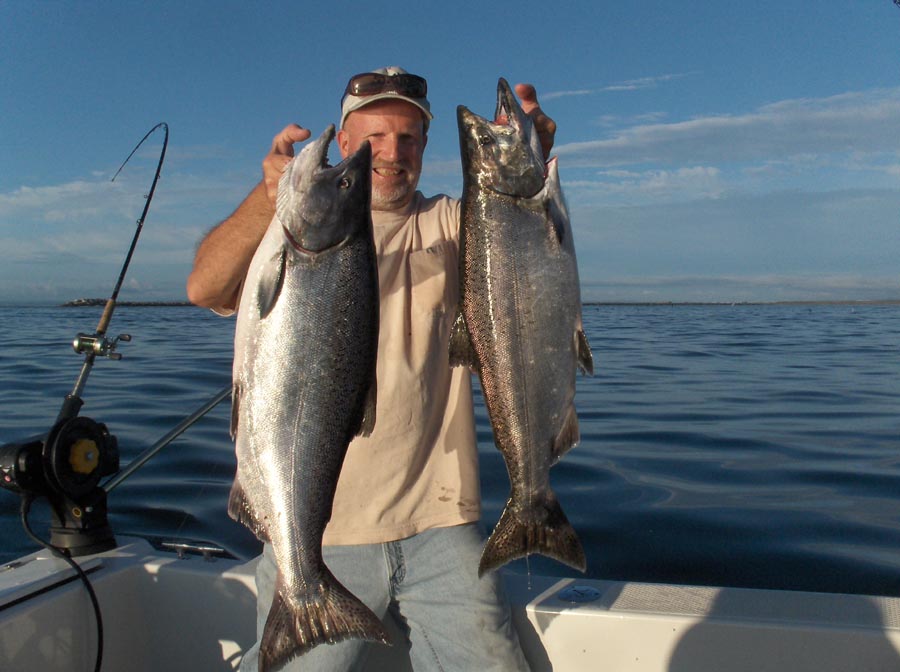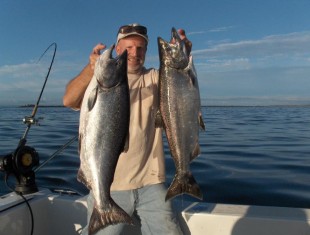
A few weeks ago, Ray Fredrick from the Kitsap Poggie Club called me about helping to catch some yelloweye rockfish in HoodCanal for a DNA research project. HoodCanal has been closed for bottom fishing since 2004, so I was more then curious about what we could find.
We would be fishing on Captain Randy Jones’ charter boat called the “Joker”, which was ex-Bremerton mayor Glenn Jarstad’s salmon charter boat he ran out of Westport in the 1960s and ‘70s.
Kelly Andrews, a fisheries research biologist from NOAA, and Dave Lowry a biologist from Washington Department of Fish and Wildlife, would do all the technical stuff like taking DNA samples, weighing and measuring, identifying species and sex.
They then would be tagging all yelloweye we caught, lowering any traumatized rockfish back to the depth they were by using a pressure-activated descending device called a Sea Qualizer.
We started our day (Sept. 15) on the dock at Alderbrook Resort near the small town of Union on HoodCanal. Our fishing crew consisted of Kitsap Poggie Club members Ron Lewis, Dave Reynard, Carol Hefner, Fredrick, Benjamin Johns and myself.
The day before we fished I called my long-time friend, Wes Schuettke, about where to start fishing for yelloweye. I always considered Wes my first friend because we were born the same day in the same hospital and our mothers shared the same hospital room.
Wes told me a Skokomish Indian we knew usually caught his yelloweye in the 1970s just north around the corner from Bald Point in 320 feet of water, so that’s where we started.
We started catching dogfish and copper rockfish right away, but no yelloweye. We moved 400 yards north and caught a few more copper rockfish. I brought up a lingcod weighing about 10 pounds, but it got off before we could net it.
We moved a little farther north and brought aboard our first yelloweye. It was really exciting because none of us were certain about finding any yelloweye in lower HoodCanal. We caught three more along with some copper rockfish.
Kelly then decided that was enough for this location, so we moved closer to Dewatto and found yelloweye heaven. We caught five more for a total of nine yelloweye up to seven and half pounds, 14 copper rockfish, eight dogfish, 10 sanddabs, two English soles, one quillback rockfish and one bullhead.
We then moved to the west side and fished north and south of Hoodsport hoping to find some canary rockfish. But we only found some sanddabs and small rockfish.
By five o’clock the joker was motoring back to Alderbrook after a very successful day. Every fish brought aboard was measured, weighed, identified, sexed and had its fin clipped for a DNA sample.
Monday was the only day I went, but Tuesday they fished north of Dewatto and caught two yelloweye. On Wednesday, they got four more in DabobBay, reaching their research limit of yelloweye for HoodCanal.
Kelly and Dave were impressed with the catch and the volunteer help. The DNA research will determine if HoodCanal yelloweye are a separate stock from the rest of Puget Sound and the ocean.
It was disappointing that no canary rockfish were caught, but that doesn’t mean there aren’t any in HoodCanal. In 2002 some were discovered during one of the low oxygen related fish kills near Hoodsport.
When I was growing up on HoodCanal in the early 1960s, yelloweye rockfish were often called red snapper. The official red snapper, however, does not inhabit our waters. To find the real ones you need to travel to the Gulf of Mexico or to the Atlantic Ocean on our southeast coast.
Yelloweye rockfish and red snapper are in the same scientific classification for Kingdom, Phylum, Class and Order, but are a different Family, Genus and Species. Red snapper can reach 40 pounds and live to be 50 years old, but yelloweye rockfish can reach 50 pounds and live to be up to 147 years old, and maybe even older.
I never fished for yelloweye when I was young because it was so easy to catch all the large copper rockfish we could eat in shallow water close to home. I caught and ate quite a few over the years while fishing in Alaska and British Columbia, some of which were probably 50 to 100 years old. The older they get the duller their bright color becomes. We usually removed the two otolith ear bones from their head. When they dry out they look and feel like ivory and make beautiful jewelry.
Yelloweye are on the threatened species list and have to be released dead or alive, but like most long-lived fish we probably shouldn’t be eating too many anyway because of excessive levels of mercury. Studies in Alaska have shown that at least five of their local fish have mercury levels that are a concern, including old yelloweye, extra large halibut, very large lingcod, salmon sharks and mature spiny dogfish.
Yelloweye are in the family Scorpaenidae and is one of the world’s longest-lived fish species. It ranges from California to Alaska and lives in water 80 to 1600 feet deep, but is usually found from 200 to 600 feet deep near the bottom.
These fish don’t reach sexual maturity until 10 to 20 years of age and like all rockfish are ovoviparous, meaning they are internally fertilized and release live young.
By the time females are 30 years old they have the ability to release 2.5 million young annually, usually in June. These tiny larval drift near the surface sometimes hundreds of miles out at sea for three month or more feeding on anything smaller then them. But they are also food for anything bigger then them and few survive that first year of life.
If they are lucky they will be near shore when they turn into tiny fish so they can hide and feed in the kelp beds and rocks. When they get bigger they venture off to deeper water, eventually finding suitable habitat in 200 to 600 feet of water. They may spend the next hundred years in a small area.
They will eat pretty much anything they can capture and will swim very fast for short bursts when feeding. Their diet includes crabs, shrimp, snails, herring, sand lance and any size bottom fish they can swallow head first including their own species.
The good news is Yelloweye rockfish are doing better in HoodCanal then anyone expected.

